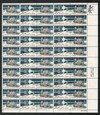
# 1434-35 - 1971 8c Space Achievements
Astronauts Take Lunar Rover For First Drive On The Moon
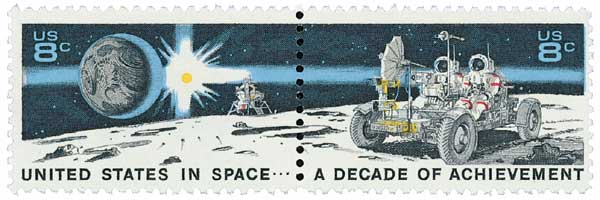
On July 31, 1971, U.S. Astronauts David Scott and James Irwin became the first humans to drive on the moon.
Over a decade before the moon landing, scientists speculated about the possibility of traveling the lunar surface. As early as 1952, Wernher von Braun wrote published a series of articles titled Man Will Conquer Space Soon!â which discussed the logistics of a six-week stay on the moon. By the mid 1960s, von Braun, then director of NASAs Marshall Space Flight Center, revealed that research had already begun for lunar vehicles.
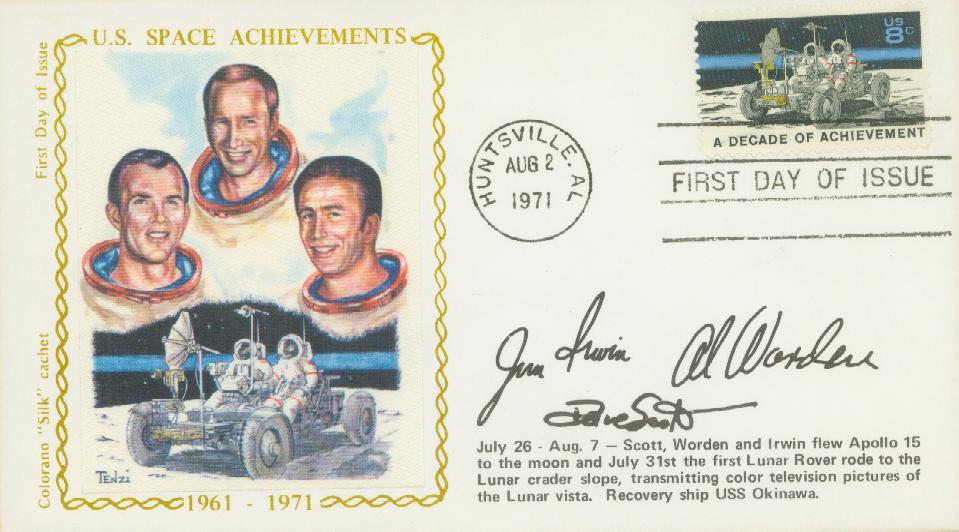
But the drive to keep costs down meant that no lunar vehicles were ready by the time we landed the first men on the moon in 1969. However, following that success, funding was granted for the creation of lunar rovers. They were developed in just 17 months and cost $38 million (for four rovers).
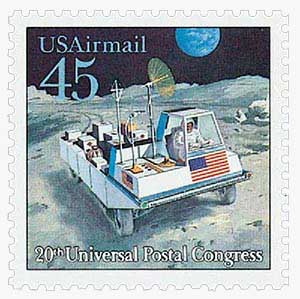
The result was like something out of the future. Made out of a variety of lightweight alloys, the 463-pound rovers could carry up 1,080 pounds. They were folded so they could fit in the cargo bay and locked into place as they were removed and opened up. The rovers could reach a top speed of eight miles per hour. (Though Apollo 17 astronaut Eugene Cernan set the lunar land-speed record at 11.2 miles per hour in 1972.)
Between July 31 and August 2, the Apollo 15 crew traveled 15.7 miles on the moons surface (more than the 4.2 miles covered by all previous expeditions on foot). They also collected about 170 pounds of lunar material to bring back to earth for examination.
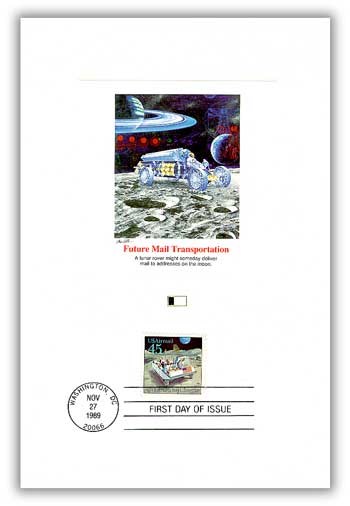
While the mission was a success, it came under scrutiny. The astronauts had brought postage stamps in their space suits without permission, and planned to sell them when they returned to earth.
Rovers were used again for the Apollo 16 and 17 missions, which covered another 40 miles of the moons surface. One astronaut from the Apollo 17 mission stated the Lunar Rover proved to be the reliable, safe and flexible lunar exploration vehicle we expected it to be. Without it, the major scientific discoveries of Apollo 15, 16, and 17 would not have been possible; and our current understanding of lunar evolution would not have been possible.
For those interested in the inner workings of the rovers, you can read the owners manual here.
Click here to see a NASA video about the Apollo 15 mission and here to see a neat video of the unar rover grand prix from the Apollo 16 mission.
Astronauts Take Lunar Rover For First Drive On The Moon

On July 31, 1971, U.S. Astronauts David Scott and James Irwin became the first humans to drive on the moon.
Over a decade before the moon landing, scientists speculated about the possibility of traveling the lunar surface. As early as 1952, Wernher von Braun wrote published a series of articles titled Man Will Conquer Space Soon!â which discussed the logistics of a six-week stay on the moon. By the mid 1960s, von Braun, then director of NASAs Marshall Space Flight Center, revealed that research had already begun for lunar vehicles.

But the drive to keep costs down meant that no lunar vehicles were ready by the time we landed the first men on the moon in 1969. However, following that success, funding was granted for the creation of lunar rovers. They were developed in just 17 months and cost $38 million (for four rovers).

The result was like something out of the future. Made out of a variety of lightweight alloys, the 463-pound rovers could carry up 1,080 pounds. They were folded so they could fit in the cargo bay and locked into place as they were removed and opened up. The rovers could reach a top speed of eight miles per hour. (Though Apollo 17 astronaut Eugene Cernan set the lunar land-speed record at 11.2 miles per hour in 1972.)
Between July 31 and August 2, the Apollo 15 crew traveled 15.7 miles on the moons surface (more than the 4.2 miles covered by all previous expeditions on foot). They also collected about 170 pounds of lunar material to bring back to earth for examination.

While the mission was a success, it came under scrutiny. The astronauts had brought postage stamps in their space suits without permission, and planned to sell them when they returned to earth.
Rovers were used again for the Apollo 16 and 17 missions, which covered another 40 miles of the moons surface. One astronaut from the Apollo 17 mission stated the Lunar Rover proved to be the reliable, safe and flexible lunar exploration vehicle we expected it to be. Without it, the major scientific discoveries of Apollo 15, 16, and 17 would not have been possible; and our current understanding of lunar evolution would not have been possible.
For those interested in the inner workings of the rovers, you can read the owners manual here.
Click here to see a NASA video about the Apollo 15 mission and here to see a neat video of the unar rover grand prix from the Apollo 16 mission.







